France–Poland relations
Polish–French relations date back several centuries, although they really only became relevant in the times of the French Revolution and the reign of Napoleon I. Poles were allies of Napoleon; a large Polish community settled in France in the 19th century. The French government sympathized with Polish rebels in 1830 and 1863 but did not intervene. Poland and France were allies during the interwar period, 1919–1939. France and Great Britain declared war on Nazi Germany when it invaded Poland in 1939, but France was accused of failing to act accordingly. The two countries were on opposite sides during the Cold War. Although never in history has a Polish Army fought against France, repeated accusations of French betrayal has influenced the relations between the two nations. It contributed to a cold attitude from Poland to France, despite their alliance since the fall of communism in Poland in 1989.
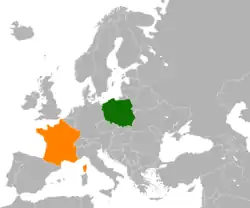 | |
Poland |
France |
|---|---|
Currently, both countries are part of the European Union, NATO and OECD. Poland is also an observer in the Organisation internationale de la Francophonie.
Comparison
| Coat of Arms | 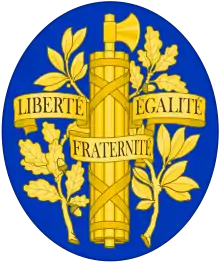 |
 |
| Population | 67,087,000 | 38,383,000 |
| Area | 674,843 km2 (260,558 sq mi) | 312,696 km2 (120,733 sq mi) |
| Population Density | 116/km2 (301/sq mi) | 123/km2 (318/sq mi) |
| Capital | Paris | Warsaw |
| Largest City | Paris – 2,234,105 (12,161,542 Metro) | Warsaw – 1,790,658 (3,100,844 Metro) |
| Government | Unitary semi-presidential constitutional republic | Unitary semi-presidential constitutional republic |
| Official language | French (de facto and de jure) | Polish (de facto and de jure) |
| Current Leader | President Emmanuel Macron Prime Minister Jean Castex |
President Andrzej Duda Prime Minister Mateusz Morawiecki |
| Main religions | 58% Christianity, 31% non-religious, 7% Islam, 1% Judaism, 1% Buddhism, 2% other |
92.9% Christianity, 3.1% non-religious, 2.7% unstated, 1.3% other |
| Ethnic groups | 86% French, 7% other European, 7% North African, other Sub-Saharan African, Indochinese, Asian, Latin American and Pacific Islander. |
98% Polish, 2% other or unstated [1][2] |
| GDP (PPP) | $2.590 trillion, $43,550 per capita | $1.353 trillion, $35,651 per capita |
| GDP (nominal) | $2.846 trillion, $39,932 per capita | $607 billion, $15,988 per capita |
| Expatriate populations | 5,860 French citizens live in Poland (2017)[3] | 350,000 Polish citizens live in France (2012)[4] |
| Military expenditures | $62.5 billion | $13.7 billion |
History
Before the 18th century
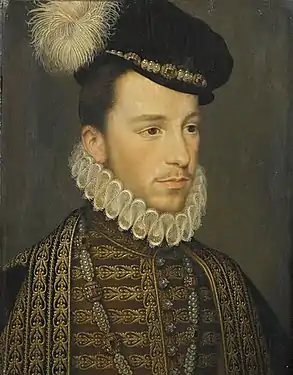
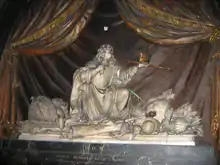
Polish–French relations were nascent until the 18th century, due to geographical distance and the Polish–Lithuanian Commonwealth's lack of involvement in the wars of Western Europe. A notable exception occurred in 1573, when Henry III of France was elected king of Poland, but he retired from that position the next year. The French Order of the Holy Spirit was dedicated to the Holy Spirit for commemorating Henry III's succession as king of Poland (1573) and France (1574) on two Pentecosts.
Two Polish kings, Władysław IV Vasa and John II Casimir, were married to French princess Ludwika Maria Gonzaga. After his abdication in 1668, John II Casimir returned to France, where he joined the Jesuits and became abbot of Saint-Germain-des-Prés in Paris. His heart was buried there. In the late 17th century, King John III Sobieski married French princess Marie Casimire Louise de la Grange d'Arquien and tried to forge a Polish–French alliance.
Charles-Paris d'Orléans; François Louis, prince of Conti; Henri Jules, prince of Condé; and Louis, prince of Condé were candidates for the Polish throne.
18th century
In the early 18th century, Stanisław I Leszczyński, king of Poland, who tried to continue Sobieski's efforts and align Poland and France, after losing a civil war in Poland, retired to France. In the mid-18th century, his daughter, Princess Marie Leszczyńska was the queen consort of France and wife of Louis XV.
During the anti-Russian Confederation of Bar the French Court Royal supported the Polish confederates by sending French officers under Charles François Dumouriez. In the late 18th century both Poland and France entered a revolutionary period, with the French Revolution being a major influence on the reforms of the Great Sejm in Poland. There was, however, never any official Polish–French alliance; in fact France was content to deflect some of its troubles by not allying itself with Poland, as Poland's neighbors, the (Kingdom of Prussia, Austrian Empire, and the Russian Empire), expecting a formation of such an alliance, and seeing Polish reforms as a sign of Jacobinite influence, were busy carrying out the partitions of Poland and had less resources to spare to deal with events in France.
Napoleonic era
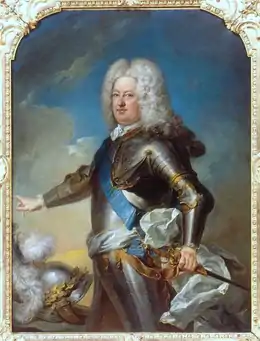
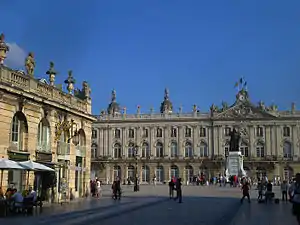
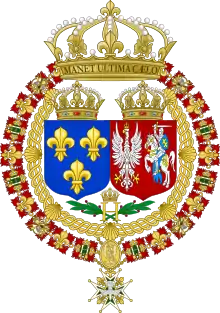
Napoleon's creation of the Duchy of Warsaw gave every appearance of resurrecting the Polish nation from the political grave to which it had been consigned in the partitions that ended in 1795.[5] Russia defeated Napoleon and made the 'independence' no more meaningful than that of Congress Poland, which emerged from the Vienna settlement. However, the Duchy represented the hope of true independence, whereas Congress Poland was always in Russia's shadow.
The other lasting significance of Napoleon's Grand Duchy is that it cast off old feudal Poland to some degree under the rule of the partitioning powers. Serfdom was abolished and a modern legal code based on the French model was introduced. Critical was the contribution the Napoleonic period made towards the creation of a national legend or myth, which was to sustain and comfort Poles down the decades that followed. Amongst other things, it contributed to a belief that the rest of Europe had an abiding interest in the fate of Poland, arising from Bonaparte's support in 1797 for the formation of Polish Legions, recruited from amongst émigrés and other exiles living in Italy. The Polish national anthem, "Dąbrowski's Mazurka", is a celebration of the legion's commander, Jan Henryk Dąbrowski, and Napoleon is only mentioned in passing. Napoleon's treatment of these soldiers was cynical in the extreme. After the Treaty of Lunéville in 1801, they were sent to the West Indies to suppress the slave revolt in the French colony Saint-Domingue, or modern Haiti.
Napoleon continued to use Poles where it suited him best. Of the fresh forces raised after the creation of the Grand Duchy of Warsaw, some 10,000 were sent to fight against the Spanish and the British in the Peninsular War. However, the Poles were most enthusiastic about the 1812 war against Russia-which Napoleon called the Second Polish War-as they formed by far the largest foreign contingent of the Grand Army. There is no precise information on what form the peace would have taken if Napoleon had won his war against Alexander, but many Poles held to the belief that it would, at the very least, have led to a fully restored Poland, including Lithuania; a return, in other words, to the situation prior to the first partition in 1772. The whole experience of the Grand Duchy of Warsaw is one of Polish confidence in Napoleon's promise of a better future, though there is really nothing that proves he would have fulfilled these expectations.
Polish national determination did impact Czar Alexander I, as he accepted that there could be no return to the position prevailing in 1795, when Poland had been extinguished. On his insistence, lands that had fallen to Prussia on the Third Partition, including the city of Warsaw, became part of his new 'Polish State', a satellite state that had a high degree of political latitude and one that preserved the Napoleonic code. Alexander may have hoped to transfer some of the fierce loyalty the Poles had formerly shown towards his great rival towards himself; but he merely perpetuated a myth. The hope of a liberal Poland, of Napoleon's Poland was kept alive, until it was all but destroyed in the uprising of 1830–1831. Thereafter, most of those who went into exile sought refuge in France, the home of the Napoleon myth, which gave it fresh life. In 1834, from his Paris exile, Adam Mickiewicz wrote his epic poem, Pan Tadeusz, which celebrates Napoleon's entry into Lithuania in 1812 thus; All sure of victory, cry with tears in eyes/God is with Napoleon, and Napoleon is with us!
Although the legend declined over the years, especially as Napoleon III offered no support to the Polish rising of 1863, it did not altogether die. It received fresh encouragement in 1918, as France was the only western power that offered unqualified support to the newly independent Poland. May 5, 1921, the hundredth anniversary of Napoleon's death, was formally marked by commemorations across the new nation. And he lives, and will continue to live, in the national anthem.
Great Immigration

The Great Emigration was an immigration of political elites from Poland from 1831–1870, particularly after the November and January uprisings. Since the end of the 18th century, people who carried out their activities outside the country as emigres played a major role in Polish political life. Because of this emigration of political elites, much of the political and ideological activity of the Polish intelligentsia during the 18th and 19th centuries was done outside of the lands of partitioned Poland. Most of those political émigrés were based in France, seen by the Poles - freshly influenced by Napoleon - as the bastion of liberty in Europe.[6]
It was during that era that some celebrated Poles came to live in France, such as the composer Frédéric Chopin, writers like Adam Mickiewicz, Cyprian Norwid or entrepreneurs like Louis Wolowski and Citroen and much later, the scientist Maria Skłodowska-Curie (Marie Curie).
Interwar period
Poland and France were political and military allies during the interwar period. The political agreement signed in Paris on February 19, 1921 established cooperation between them.[7][8] Starting with the Blue Army that aided France in World War I and the French Military Mission to Poland during the Polish–Soviet War (1919–1921), the Franco-Polish Military Alliance was signed in 1921 and continued until the German invasion of Poland.
World War II
France declared war on Germany when it invaded Poland in 1939, but was unable to halt the quick contest, Indeed, France itself fell to Germany in 1940. After Nazi Germany's invasion and occupation of Poland, a new Polish Army formed in France under the command of General Władysław Sikorski in late 1939. Polish units included the 1st Grenadiers Division, among others. Polish–French relations ceased 1940–44. Some Poles became part of the French Resistance.[9] Despite this, France was blamed for betraying its promise to help in Poland, due to the alliance treaty signed between Poland and France prior to World War II; later it was extended after large territories in the East of Poland was annexed by the Soviet Union, which eventually became modern Belarus, Ukraine and Lithuania.[10]
Cold War
During the Cold War, Polish–French relations were poor, due to both countries being on the opposite sides of the Cold War. However France was - again - a site of a thriving Polish emigrant community (see Kultura and Jerzy Giedroyc). Other prominent members of the Polish community in France of that period have included Rene Goscinny.
Post-1991
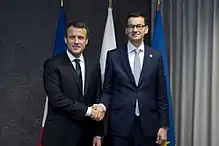
Polish–French relations have improved after the fall of communism. Poland, France and Germany are part of the Weimar Triangle which was created in 1991 to strengthen cooperation between the three countries.
France, as a founding member of the European Community, European Union, and NATO, as well as a permanent member of the United Nations Security Council and nuclear power, is one of Poland's principal political, economic, cultural, scientific and technological partners.
The year 2004 marked a breakthrough in Polish–French relations. After a period of tension caused by different approaches to the Iraq crisis and the European Constitution negotiations, relations improved. After the accession of Poland to the European Union on May 1, 2004, meetings of the heads of state from both countries have been organized yearly.
France is the largest contributor of foreign direct investment in Poland. The French companies with the largest presence in Poland include Orange, Vivendi, Carrefour, Casino, Crédit Agricole, Saint Gobain and Auchan.
Controversy was caused by the phrase "Polish Plumber", which appeared in France around 2005.[11]
About one million ethnic Poles live in France, concentrated in the Nord-Pas de Calais region, in the metropolitan area of Lille and the coal-mining region (bassin minier) around Lens and Valenciennes. Polish mineurs' descendants are also found in Auberny.
Poland and France have held intergovernmental consultations on several occasions.[12][13] The last (out of date?) such summit took place on November 23, 2017 in Paris with President Emmanuel Macron and Prime Minister Beata Szydło.
Resident diplomatic missions
- France has an embassy in Warsaw and a consulate-general in Kraków.[14]
- Poland has an embassy in Paris and a consulate-general in Lyon.[15]
.jpg.webp) Embassy of France in Warsaw
Embassy of France in Warsaw Consulate-General of France in Kraków
Consulate-General of France in Kraków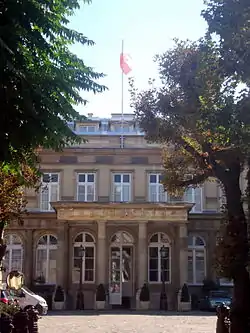 Embassy of Poland in Paris
Embassy of Poland in Paris Consulate-General of Poland in Lyon
Consulate-General of Poland in Lyon
See also
References
- Struktura narodowo-etniczna, językowa i wyznaniowa ludności Polski. Narodowy Spis Powszechny Ludności i Mieszkań 2011 [National-ethnic, linguistic and religious structure of Poland. National Census of Population and Housing 2011] (PDF) (in Polish). Central Statistical Office. 2015. ISBN 978-83-7027-597-6.
- Ludność. Stan i struktura demograficzno-społeczna. Narodowy Spis Powszechny Ludności i Mieszkań 2011 [Population. Number and demographical-social structure. National Census of Population and Housing 2011] (PDF) (in Polish). Central Statistical Office. 2013. ISBN 978-83-7027-521-1.
- "HOW MANY EXPATS LIVE IN POLAND?". Retrieved 27 July 2020.
- "Europe: where do people live?". Retrieved 27 July 2020.
- John Stanley, "French Attitudes toward Poland in the Napoleonic Period." Canadian Slavonic Papers 49.3-4 (2007): 209-227.
- Zubrzycki, 1953
- Text in League of Nations Treaty Series, vol. 18, pp. 12-13.
- Text of the agreement
- Jan Karski,The Great Powers & Poland, 1919-1945: from Versailles to Yalta (UP of America, 1985).
- http://www.worldfuturefund.org/wffmaster/Reading/History/polandbetrayal.htm
- "France's New Media Star? The Polish Plumber". Retrieved 28 July 2020.
- "Polsko-francuskie konsultacje międzyrządowe". Retrieved 28 July 2020.
- "Polish-French intergovernmental consultations". Retrieved 28 July 2020.
- Embassy of France in Poland
- Embassy of Poland in France
Further reading
- Cienciala, Anna, and Titus Komarnicki. From Versailles to Locarno: Keys to Polish Foreign Policy, 1919-1925 (1984)
- Cienciala, Anna. Poland and the Western Powers, 1938-1939: A Study in the Interdependence of Eastern and Western Europe, (1968)
- Davies, Norman. God's Playground: A History of Poland, Vol. 1: The Origins to 1795 (2005)
- Davies, Norman. God's Playground: A History of Poland, Vol. 2: 1795 to the Present (2005)
- Karski, Jan. The Great Powers & Poland, 1919-1945: from Versailles to Yalta (UP of America, 1985).
- Lobanov-Rostovsky, Andrei. Russia and Europe, 1825-1878 (1954)
- Lobanov-Rostovsky, Andrei. Russia and Europe 1789-1825 (1968)
- MacDonald, Callum A. "Britain, France and the April crisis of 1939." European Studies Review 2.2 (1972): 151–169.
- Majchrowski, Tomasz and Adam Halamski. "Polish–French Relations", Yearbook of Polish Foreign Policy (01/2005),
- Nieuwazny, Andrzej. "Napoleon and Polish identity" History Today, Vol. 48, May 1998 , and
- Pasztor, Maria. "France, Great Britain, and Polish conceptions of disarmament, 1957-1964." Acta Poloniae Historica 90 (2004): 113–155. online
- Roberts, Geoffrey. "The Alliance that Failed: Moscow and the Triple Alliance Negotiations, 1939." European History Quarterly 26.3 (1996): 383–414.
- Stanley, John. "French Attitudes toward Poland in the Napoleonic Period." Canadian Slavonic Papers 49.3-4 (2007): 209–227.
- Urbaniak, George. "French involvement in the Polish-Lithuanian dispute, 1918–1920." Journal of Baltic Studies 16.1 (1985): 52–63.
- Wandycz, Piotr S. France and Her Eastern Allies, 1919-1925: French-Czechoslovak-Polish Relations from the Paris Peace Conference to Locarno (1962).
- Wandycz, Piotr S. "French Diplomats in Poland 1919-1926." Journal of Central European Affairs 23#$ (1964): 440–50.
- Wandycz, Piotr S. "General Weygand and the Battle of Warsaw of 1920." Journal of Central European Affairs 19#4 4 (1960): 357–65.
- Weber, Pierre-Frédéric. "France, Poland, and Germany’s Eastern Border, 1945–1990." in France and the German Question, 1945–1990 (2019).
- Zawadzki, Hubert. "Between Napoleon and Tsar Alexander: The Polish Question at Tilsit, 1807." Central Europe 7.2 (2009): 110–124.
Zubrzycki, J. (1953). "Emigration from Poland in the Nineteenth and Twentieth Centuries". Population Studies: A Journal of Demography. 6 (3): 248–272. doi:10.1080/00324728.1953.10414889.
External links
- (in French) Echanges franco-polonais - Polish–French relations described on the pages of the Polish Embassy in France
- (in Polish) Stosunki francusko-polskie - post-1991 relations described on the pages of the French Embassy in Poland
- (in Polish) Wojsko Polskie we Francji. Świat Polonii. - on 1940 Polish Army in France
- Maciej Serwanski, Henryk III Walezy w Polsce: Stosunki polsko-francuskie w latach 1566-1576, JSTOR review